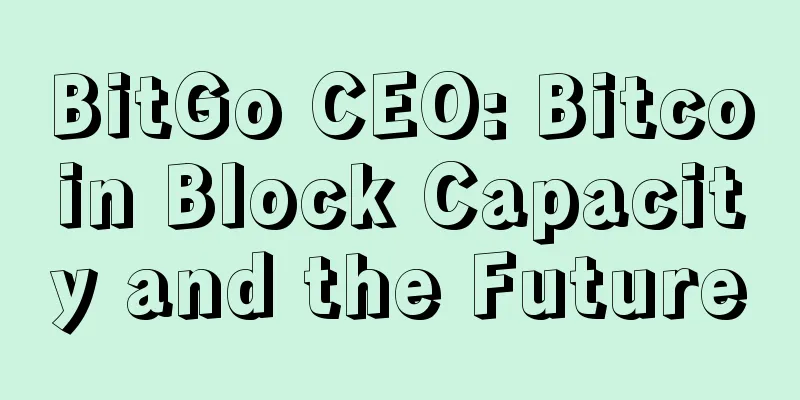BitGo CEO: Bitcoin Block Capacity and the Future

|
Note: The author of this article, Mike Belshe, is the inventor of the famous network protocol SPDY and the CEO of BitGo. This article was written on January 18, 2016, and was published to Babbitt by Zhong Yin at the request of Peter Smith, CEO of Blockchain. BitGo Company Introduction: BitGo is a Bitcoin security platform that has raised $12 million in Series A funding. In the most recent quarter, the Bitcoin transaction volume on the BitGo platform has exceeded $1 billion. Today, one of BitGo's key customers complained to us that their transactions were not being confirmed. Why were they not being confirmed? Oh, because the blocks were full. They had set the correct transaction fees, and the BitGod platform dynamically calculated the transaction fees every time, but the surge in demand caused their transactions to not be confirmed. A large number of small-scale Bitcoin exchanges are now suffering losses due to the Bitcoin Core flaw. So, I have something to say. 1. Bitcoin development has gone too far I'm sorry, Bitcoin developers, but you're wrong to worry that increasing the block size will ruin Bitcoin. You're doing what Donald Knuth warned you not to do - premature optimization. We don't have hard data on whether a 2MB block will affect block delivery or centralization. If you're right, increasing the block size will require more optimization, but we'll optimize and solve problems when we encounter them. From my own experience building HTTP/2.0, there's only one thing I know for sure about optimization: you never know what you can optimize until you try it. Premature optimization is the root of all evil. — Donald Knuth 2. We already have a consensus Data shows that 90% of community members have agreed to expand the block size to at least 2MB. If 90% of people's opinions are not considered "consensus", I don't know what consensus is. From my experience in standard-setting organizations, standards always require compromise. Whether you can accept it or not, the community will move forward according to the consensus. 3. Bitcoin is already centralized The core argument against increasing the block size is that it will lead to more centralization of Bitcoin. I wish it wasn’t the case, but the battle is won and lost. Starting with mining pools, the rapid advancement of hardware has made individual nodes a drop in the ocean. No matter how you look at it, it only takes a handful of companies to destroy Bitcoin. Of course, Bitcoin is not as centralized as e-gold, a product that only one company dominates, but it is clearly a far cry from the decentralized sanctuary that Satoshi envisioned. Don’t get me wrong, we all want a decentralized system, but block size is not the crux of the matter. 4. SegWit and Lightning Network are a distant dream Segregated Witness and Lightning Network are both good solutions to the problem. I like both of them. However, neither is ready yet and will not be available for 6-18 months. Lightning Network is even riskier and may end up being completely unworkable. Further, if you think decentralization is hard for the existing Bitcoin system, consider whether pushing the problem onto an unproven software is more likely to make it worse. Unfortunately, we need to solve the block size problem today. It would be a big mistake to delay Bitcoin because of these experimental technologies. 5. We are out of time Finally, we simply don’t have time to waste. A payment system that can only handle 300,000 transactions per day is not worth my time or anyone else’s. I doubt Elon Musk would want to spend time on such a pathetic, minuscule system. I doubt Larry Page, Steve Jobs, or Warren Buffet would make such a choice. If we want to change the world, we have to be more ambitious. Multiply the world's largest trading system by 1,000 times. That's what we should do. We don't have time to waste on systems that don't change the world. If you want to see any change, now is the time to start. Otherwise, soon the next generation of real thought leaders will throw away Bitcoin and make real innovations to change the world. ————————– |
<<: Bidorbuy, Africa's Largest Online Marketplace, Accepts Bitcoin Payments
>>: Why Bitcoin is not the root cause of ransomware
Recommend
Explanation of the glyph patterns in the palm lines
Everyone's palm lines are different, and ever...
The reflection of good fortune on the face
The laws of human fortune cannot be reversed, but...
Crypto firm BitPay fined for violating US sanctions
BitPay will have to pay more than $500,000 to the...
China's blockchain industry under the shadow of the epidemic: meetings postponed, mining machine sales suspended
Author: Ratchet Pizza Under the shadow of the new...
Look at the mouth shape to avoid choosing the wrong person
Look at the mouth shape to avoid choosing the wro...
The face of a woman with high brow bones
The face of a woman with high brow bones Judging ...
Iranian minister says Chinese miners are taking advantage of Iran's cheap electricity
According to beincrypto, Iran’s Minister of Commu...
What kind of sparks will be created when Filecoin meets DeFi?
Professionalism and focus, win-win cooperation Du...
What does a woman with a big nose mean?
In physiognomy, people with different facial feat...
The idealistic developer’s dilemma: Who will help Grin?
Grin is a very popular project in the US crypto V...
What does a middle-aged widow look like?
Losing one’s husband is a very sad and painful th...
A man sold his property to buy Bitcoin when it was $900: He was afraid of losing it after getting rich, so he stored it in six countries
Original title: A man sold his property to buy Bi...
Will fragmentation kill blockchain adoption in the identity market?
Blockchain identity recognition technology can en...
Data: The number of addresses holding more than 0.1 BTC exceeds 3 million, a record high
Small Bitcoin (BTC) ownership continues to increa...
Is it bad for a man to have two horizontal lines on his forehead?
Is it bad for a man to have two horizontal lines ...









